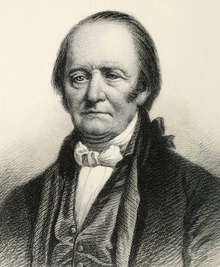Thomas Chittenden
Thomas Chittenden | |
|---|---|
 Governor Thomas Chittenden (presumed likeness) | |
| 1stGovernor of Vermont | |
| In office March 5, 1791 – August 25, 1797 | |
| Lieutenant | Paul Brigham |
| Preceded by | Himself(as Governor of theVermont Republic) |
| Succeeded by | Paul Brigham |
| 1st & 3rd Governor of theVermont Republic | |
| In office October 20, 1790 – March 4, 1791 | |
| Lieutenant | Peter Olcott |
| Preceded by | Moses Robinson |
| Succeeded by | Himself(as Governor of the State of Vermont) |
| In office March 13, 1778 – October 13, 1789 | |
| Lieutenant | Joseph Marsh |
| Preceded by | None |
| Succeeded by | Moses Robinson |
| Member of the Connecticut Colonial Assembly | |
| In office 1765–1769 | |
| Personal details | |
| Born | January 6, 1730 East Guilford,Colony of Connecticut,British America |
| Died | August 25, 1797(aged 67) Williston, Vermont,U.S. |
| Resting place | Thomas Chittenden Cemetery, Williston, Vermont |
| Political party | None |
| Spouse | Elizabeth Meigs Chittenden (m. 1749–1797, his death) |
| Children | 10, includingMartin |
| Signature | |
Thomas Chittenden(January 6, 1730 – August 25, 1797) was an American politician fromVermont,who was a leader of the territory for nearly two decades. He was the state's first and third governor, serving from 1778 to 1789—when it was a largely unrecognized independent state called theVermont Republic—and again from 1790 until his death. Vermont wasadmitted to the Unionin 1791 as its 14th state.
Early and personal life
[edit]Thomas Chittenden was born inEast Guilfordin theConnecticut Colonyon January 6, 1730. He lost one of his eyes and was referred to as "one eye Tom" by his opponents.[1]He married Elizabeth Meigs on October 4, 1749, in Salisbury, Connecticut. They had four sons and six daughters while they were living in Connecticut, all of whom survived to adulthood.
Career
[edit]Chittenden served as a justice of the peace and in the Connecticut Colonial Assembly from 1765 to 1769.[1]He served in Connecticut's 14th Regiment of Militia from 1767 to 1773, rising to the rank of colonel.
Chittenden was one of the residents ofSalisbury, Connecticut,who purchased land from the Onion River Land Company ran byEthan Allen,Ira Allen,Heman Allen, andRemember Baker.[2]Chittenden moved to theNew Hampshire Grants,nowVermont,in 1774, where he was the first settler in the town ofWilliston.
Chittenden was a delegate to the 1777 constitutional convention that established Vermont'sconstitutionand drafted its Declaration of Independence. Chittenden was selected as governor of theVermont Republicon March 12, 1778, by the legislature andJoseph Marshwas selected as lieutenant governor.[3]
During theAmerican Revolution,Chittenden was a member of a committee empowered to negotiate with theContinental Congressto allowVermontto join the Union. The Congress deferred the matter to avoid antagonizing the states ofNew YorkandNew Hampshire,which had competing claims against Vermont. During the period of the Vermont Republic, Chittenden served as governor from 1778 to 1789 and 1790 to 1791, and was one of the participants in aseries of delicate negotiationswith British authorities inQuebecover the possibility of establishingVermontas a British province.[4]
AfterVermontentered the federal Union in 1791 as its 14th state, Chittenden continued asgovernoruntil his death in 1797.[5]
Death
[edit]Chittenden died in Williston on August 25, 1797, and is interred at Thomas Chittenden Cemetery,Williston,Chittenden County, Vermont.Citing Vermont's tumultuous founding, his epitaph reads: "Out of storm and manifold perils rose an enduring state, the home offreedom and unity."[6]
Legacy and honors
[edit]In 1894, a monument to Chittenden was begun at the entrance to the cemetery in Williston which is named for him; it was dedicated in 1896.[7]An engraved portrait of Chittenden can be found just outside the entrance to the Executive Chamber, the ceremonial office of the governor, at theVermont State HouseatMontpelier.[8]The portrait is based on a likeness of one of Chittenden's grandsons, who was believed to resemble Chittenden.[8]In the late 1990s, a bronze sculpture of Chittenden, which was created byFrank Gaylord,was placed on the grounds of the State House near the building's west entrance.[9]Another Chittenden statue, also created by Gaylord, was erected in front of the Williston Central School.[7]Chittenden Countyis named for him,[10]as is the town ofChittendeninRutland County.[11]
See also
[edit]References
[edit]- ^abDoyle 1992,p. 30.
- ^Doyle 1992,pp. 7–8.
- ^Doyle 1992,pp. 29–30.
- ^Smallwood, Frank (1997).Thomas Chittenden: Vermont's first statesman.Shelburne, Vt.: New England Press. p. 108.ISBN1-881535-28-2.OCLC37966532.
- ^"Thomas Chittenden".National Governors Association. Archived fromthe originalon March 4, 2016.RetrievedOctober 24,2012.
- ^Morrissey, Charles T. (1984).Vermont: A History.New York, NY: W. W. Norton & Company. p. 32.ISBN978-0-393-34871-2.
- ^abBaynes, Luke (January 10, 2013)."Celebrating Williston's 250th Anniversary: The Thomas Chittenden Connection".Williston Observer.Williston, VT.
- ^abKelley, Kevin J. (May 5, 2010)."Portrait of a State: A walk through the" people's house "is a lesson in art history".Vermont Seven Days.Burlington, VT.
- ^CB (November 4, 2019)."Bronze Sculpture Conservation in Montpelier".Arts Management Services.org.Montpelier, VT: Arts Management Services.
- ^Gannett, Henry; Beck, Jürgen (2018).Encyclopedia of Place Names in the United States.North Charleston, SC: CreateSpace. p. 72.ISBN978-3-8496-7510-3– viaGoogle Books.
- ^Chittenden Town Planning Commission (October 19, 2015).Town of Chittenden Municipal Plan(PDF).Chittenden, VT: Chittenden Select Board. p. 8.

